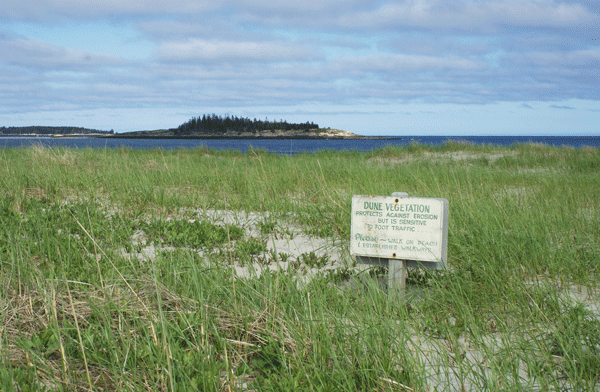More than 400 years after the Plymouth colony was established, historians are still unraveling what the New England coast looked like, before and after. One fresh understanding of that history, which came from examining the colonial impact on New Hampshire’s Great Bay, shed light on the region’s ecosystems today.
The presentation was one of several in which the past and present collided at the Beaches Conference on June 10 at Berwick Academy in Berwick, an every-other-year symposium jointly hosted by Maine and New Hampshire Sea Grant. Some 180 attended.
Paul and Denise Pouliot, members of the Cowasuck Band of the Pennacook native people, along with the University of New Hampshire’s Meghan Howey, described their study of the English settlement of Great Bay, which lies several miles upriver from the mouth of the Piscataqua.
The settler colonial period of 1600-1750, they said, “ushered in radical societal and ecological transformation that continues to shape the landscape today.”
One cod skeleton was unearthed which was determined to have … lived most of its life in the inland estuary.
They began by working to understand how the native people lived and supported themselves in the estuary before the English arrived. Rather than concluding that settlers chose the locations where the first European houses were built, the research suggests the English evicted the native people from those prime locations. They even seized native garden plots.
“Colonists came to this place because they saw the indigenous settlements and knew they could live there,” Howey said.
Among the findings archaeological digs have revealed is a buried rock they described as marked by an “oil slick.” Some of the material there was dated to 1300. Howey said speculation is that the rock, still slimy to the touch, was used to clean fish or even a whale carcass that may have washed ashore.
Paul Pouliot said the English settlers survived because native people taught them how to render moose, deer, turtle, and other animals. Perhaps surprisingly, natives did not favor cod, he said.
One cod skeleton was unearthed which was determined to have been eight years old when caught, suggesting it lived most of its life in the inland estuary.
“Talk about a healthy ecosystem,” Howey quipped.
But English infrastructure remade that ecosystem. By the early 1700s, she said, 90 dams had been built in the Great Bay region. Ironically, in England, such dams had been banned because the damage they did to fish populations was known.
The dams were “a shock to the system,” Howey said.
And the worst settler impact, of course, was a 1694 massacre of native people in the region, she said.
As sea levels rise, many of the village sites are eroding and washing away.
“Sometimes, I feel like we came to this site 20 years too late,” she said.
Also presenting archaeological research were Robert Sanford and Nathan Hamilton of the University of Southern Maine, discussing work begun in 1996 on Malaga Island in the New Meadows River in Phippsburg. Salmon and swordfish remains were found around half a dozen house sites on the island, suggesting both were readily available in the river in the 1870-1912 period when the mostly African-American population lived there.
A slide was shown of a postcard from the early 20th century with a photograph of an elderly woman and a young boy, labeled “Duce [sic] of spades,” an appalling reminder of how African-Americans were treated a century ago.
State officials forcibly removed the residents of the 41-acre island, which lies within “shouting distance” to the mainland, in 1911. The artist Daniel Minter created a series of paintings honoring the residents, and for a show at the Maine State Museum, persuaded the curator to let him build a tarpaper shack in the space to invoke how the islanders lived.
Today, there are 300 descendants of the islanders living in the area. The state recently created a fund to offer them scholarships.
Among the conference’s exhibitors was Buzz Scott of OceansWide, an organization that undertakes a removal more welcomed than that on Malaga. Scott’s organization works to retrieve so-called ghost lobster traps. In the fall of 2021, 1,177 were removed from the bottom in Boothbay Harbor. This spring, another 2,027 were removed, all in 60-feet or less of water.
Based on their tags, some of the gear has been on the bottom for years.
“We’ve hauled them up from 1999,” based on the tag information. “That’s the farthest back we’ve gone,” he said.
Trap vertical lines often are cut by recreational boat propellors, Scott said.
The organization has to haul the traps to a landfill in the Boothbay area, but in Gouldsboro, where it is based, traps are crushed with a reconfigured log splitter and sold to a recycler.
“We’ve processed maybe 4,000 traps,” he said. “There’s another 4,000 sitting in the yard right now.”
Next up is a trip to Matinicus Isle, Scott said, where 10,000 “retired” traps are stored.





